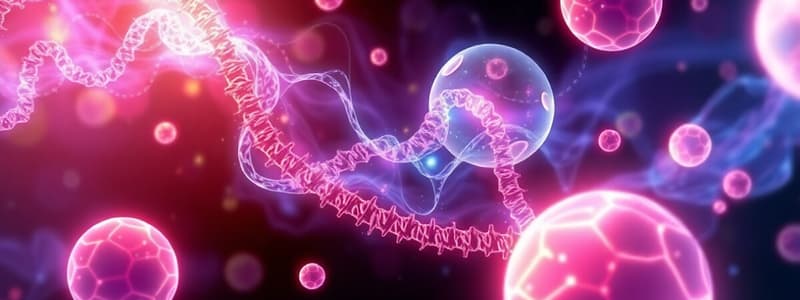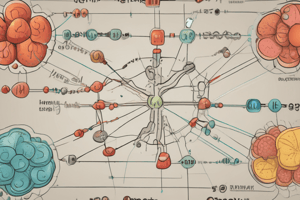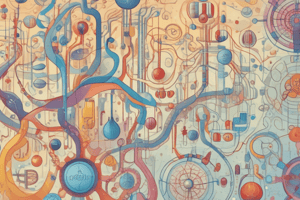Podcast
Questions and Answers
Why is it crucial for glucose derived from glycogen to enter glycolysis as glucose-1-phosphate (G1P)?
Why is it crucial for glucose derived from glycogen to enter glycolysis as glucose-1-phosphate (G1P)?
- G1P directly activates phosphofructokinase, enhancing glycolytic flux.
- It bypasses the initial ATP-consuming step of glycolysis, conserving energy. (correct)
- G1P is a more potent substrate for hexokinase, accelerating glucose phosphorylation.
- It prevents the accumulation of free glucose, avoiding osmotic stress.
In the context of carbohydrate catabolism, what is the primary function of the hydrolytic enzymes secreted in the mouth and small intestine?
In the context of carbohydrate catabolism, what is the primary function of the hydrolytic enzymes secreted in the mouth and small intestine?
- To reduce large carbohydrates into smaller, more manageable units for further digestion and absorption. (correct)
- To initiate the citric acid cycle by producing acetyl-CoA.
- To synthesize glycogen from dietary carbohydrates.
- To directly convert polysaccharides into glucose for absorption.
How does the entry point of fructose into glycolysis differ in muscles compared to the liver, and what is the regulatory significance of this difference?
How does the entry point of fructose into glycolysis differ in muscles compared to the liver, and what is the regulatory significance of this difference?
- In muscles, fructose enters as glyceraldehyde-3-phosphate, while in the liver, it enters as dihydroxyacetone phosphate, leading to different metabolic fates.
- Fructose entry is identical in both tissues, but liver cells have a higher capacity for fructose metabolism due to high fructokinase activity.
- Muscles use fructokinase to directly convert fructose to fructose-6-phosphate, bypassing PFK-1 regulation, unlike in the liver. (correct)
- Muscles lack the enzyme to metabolize fructose; thus, it is primarily processed in the liver.
What is the strategic advantage of glycogen breakdown via phosphorolysis over hydrolysis in the context of glycolysis initiation?
What is the strategic advantage of glycogen breakdown via phosphorolysis over hydrolysis in the context of glycolysis initiation?
In the context of galactose metabolism, what is the role of UDP-glucose:galactose-1-phosphate uridylyltransferase, and what implications arise from its deficiency?
In the context of galactose metabolism, what is the role of UDP-glucose:galactose-1-phosphate uridylyltransferase, and what implications arise from its deficiency?
How does the non-oxidative phase of the pentose phosphate pathway facilitate metabolic flexibility in cells that do not require ribose-5-phosphate for nucleotide biosynthesis?
How does the non-oxidative phase of the pentose phosphate pathway facilitate metabolic flexibility in cells that do not require ribose-5-phosphate for nucleotide biosynthesis?
What are the implications of a deficiency in glucose-6-phosphate dehydrogenase (G6PD) on erythrocyte function, and why does this deficiency disproportionately affect red blood cells?
What are the implications of a deficiency in glucose-6-phosphate dehydrogenase (G6PD) on erythrocyte function, and why does this deficiency disproportionately affect red blood cells?
What is the primary metabolic consequence of hereditary fructose intolerance (HFI), and how does it arise at the molecular level?
What is the primary metabolic consequence of hereditary fructose intolerance (HFI), and how does it arise at the molecular level?
What role does NADPH from the pentose phosphate pathway play in maintaining erythrocyte integrity, and how does it achieve this function?
What role does NADPH from the pentose phosphate pathway play in maintaining erythrocyte integrity, and how does it achieve this function?
How does the regulation of glucose-6-phosphate dehydrogenase (G6PD) by NADPH contribute to metabolic homeostasis, and what is the biochemical mechanism behind this regulation?
How does the regulation of glucose-6-phosphate dehydrogenase (G6PD) by NADPH contribute to metabolic homeostasis, and what is the biochemical mechanism behind this regulation?
How does the altered metabolism observed in cancer influence the pentose phosphate pathway?
How does the altered metabolism observed in cancer influence the pentose phosphate pathway?
WHich of the following is the MOST LIKELY outcome of an increased concentration of NADPH in the cell?
WHich of the following is the MOST LIKELY outcome of an increased concentration of NADPH in the cell?
What is the function of glutathione reductase?
What is the function of glutathione reductase?
How does the liver's capacity to detoxify fructose, influenced by the enzyme fructokinase, pose a risk in individuals with Hereditary Fructose Intolerance (HFI), and what are the potential consequences?
How does the liver's capacity to detoxify fructose, influenced by the enzyme fructokinase, pose a risk in individuals with Hereditary Fructose Intolerance (HFI), and what are the potential consequences?
What condition arises from a genetic defect affecting galactose metabolism, and which enzyme deficiency is most commonly associated with severe symptoms?
What condition arises from a genetic defect affecting galactose metabolism, and which enzyme deficiency is most commonly associated with severe symptoms?
Why does deficiency in transketolase cause Wernicke-Korsakoff Syndrome?
Why does deficiency in transketolase cause Wernicke-Korsakoff Syndrome?
What is the role of transketolase and transaldolase?
What is the role of transketolase and transaldolase?
The product of which of the following reactions can proceed through either glycolysis or the pentose phosphate pathway, depending on the needs of the cell?
The product of which of the following reactions can proceed through either glycolysis or the pentose phosphate pathway, depending on the needs of the cell?
A researcher is investigating a novel enzyme that converts sedoheptulose-7-phosphate and glyceraldehyde-3-phosphate to erythrose-4-phosphate and fructose-6-phosphate. Which enzyme has been discovered?
A researcher is investigating a novel enzyme that converts sedoheptulose-7-phosphate and glyceraldehyde-3-phosphate to erythrose-4-phosphate and fructose-6-phosphate. Which enzyme has been discovered?
What key role does the pentose phosphate pathway (PPP) play in red blood cells?
What key role does the pentose phosphate pathway (PPP) play in red blood cells?
Which enzyme is deficient in individuals with favism?
Which enzyme is deficient in individuals with favism?
How are individuals wth Wernicke-Korsakoff Syndrome affected by the pentose phosphate pathway?
How are individuals wth Wernicke-Korsakoff Syndrome affected by the pentose phosphate pathway?
Which is the MOST LIKELY outcome of reduced glutathione?
Which is the MOST LIKELY outcome of reduced glutathione?
Which condition is related to an abundance of hemolysis?
Which condition is related to an abundance of hemolysis?
Which antioxidant enzyme requires selenium as a cofactor?
Which antioxidant enzyme requires selenium as a cofactor?
How is the activity of glucose-6-phosphate dehydrogenase (G6PD) regulated?
How is the activity of glucose-6-phosphate dehydrogenase (G6PD) regulated?
Through which mechanism does chronic alcohol consumption interfere with thiamine absorption in the intestine and lead to Wernicke-Korsakoff syndrome?
Through which mechanism does chronic alcohol consumption interfere with thiamine absorption in the intestine and lead to Wernicke-Korsakoff syndrome?
What is the role of the enzyme phosphoglucomutase?
What is the role of the enzyme phosphoglucomutase?
Choose the correct statement.
Choose the correct statement.
Which statement BEST describes the role of glutathione in red blood cells?
Which statement BEST describes the role of glutathione in red blood cells?
A researcher studying carbohydrate metabolism discovers a new enzyme that catalyzes the transfer of a two-carbon unit from a ketose to an aldose. What can you infer?
A researcher studying carbohydrate metabolism discovers a new enzyme that catalyzes the transfer of a two-carbon unit from a ketose to an aldose. What can you infer?
Which statement is true regarding the role and regulation of the non-oxidative phase of the pentose phosphate pathway (PPP)?
Which statement is true regarding the role and regulation of the non-oxidative phase of the pentose phosphate pathway (PPP)?
Which of the following regarding reactive oxygen species (ROS) is true?
Which of the following regarding reactive oxygen species (ROS) is true?
Which enzyme is used in the synthesis of the NADPH required by mammalian cytochrome P450 monooxygenases?
Which enzyme is used in the synthesis of the NADPH required by mammalian cytochrome P450 monooxygenases?
Flashcards
Feeder pathways
Feeder pathways
The pathways that feed into glycolysis, allowing various carbohydrates to enter the pathway at different points.
Carbohydrate digestion
Carbohydrate digestion
The initial mechanical and chemical breakdown of carbohydrates begins with chewing and saliva.
Hydrolytic Enzymes
Hydrolytic Enzymes
Enzymes that catalyze the hydrolysis of glycosidic bonds, breaking down complex carbohydrates into smaller units.
Glycogen/starch
Glycogen/starch
Signup and view all the flashcards
Phosphorylase
Phosphorylase
Signup and view all the flashcards
Phosphoglucomutase
Phosphoglucomutase
Signup and view all the flashcards
Phosphorolysis
Phosphorolysis
Signup and view all the flashcards
Energy savings
Energy savings
Signup and view all the flashcards
UDP-galactose
UDP-galactose
Signup and view all the flashcards
Fructose in Liver
Fructose in Liver
Signup and view all the flashcards
Hereditary Fructose Intolerance (HFI)
Hereditary Fructose Intolerance (HFI)
Signup and view all the flashcards
Galactosemia
Galactosemia
Signup and view all the flashcards
Sugar nucleotide
Sugar nucleotide
Signup and view all the flashcards
Lactose intolerance
Lactose intolerance
Signup and view all the flashcards
Pentose Phosphate Pathway (PPP)
Pentose Phosphate Pathway (PPP)
Signup and view all the flashcards
Pentose Phosphate Pathway
Pentose Phosphate Pathway
Signup and view all the flashcards
Metabolic Shunt
Metabolic Shunt
Signup and view all the flashcards
G6PDH Function
G6PDH Function
Signup and view all the flashcards
Points of contact
Points of contact
Signup and view all the flashcards
PPP Phases
PPP Phases
Signup and view all the flashcards
Oxidative Phase
Oxidative Phase
Signup and view all the flashcards
Non-Oxidative phase
Non-Oxidative phase
Signup and view all the flashcards
Glutathione
Glutathione
Signup and view all the flashcards
NADPH function as reductant
NADPH function as reductant
Signup and view all the flashcards
Redundancy in PPP
Redundancy in PPP
Signup and view all the flashcards
NADPH Role
NADPH Role
Signup and view all the flashcards
Reactive Oxygen Species (ROS)
Reactive Oxygen Species (ROS)
Signup and view all the flashcards
Antioxidant enzymes
Antioxidant enzymes
Signup and view all the flashcards
ETC ROS
ETC ROS
Signup and view all the flashcards
Glutathione Activity
Glutathione Activity
Signup and view all the flashcards
NADPH Role in RBC
NADPH Role in RBC
Signup and view all the flashcards
Favism
Favism
Signup and view all the flashcards
G6PD Deficiency
G6PD Deficiency
Signup and view all the flashcards
Wernicke-Korsakoff Syndrome
Wernicke-Korsakoff Syndrome
Signup and view all the flashcards
Study Notes
- Feeder pathways supply glycolysis with fuel
- These pathways ensure glycolysis has a continuous supply of carbohydrates, regardless of the source
Feeder Pathways Overview
- Glycolysis requires carbohydrates, and feeder pathways make sure these are available
Types of Carbohydrates
- Glycogen
- Starch
- Trehalose
- Sucrose
- Lactose
Glycolysis Entry Points
- Carbohydrates enter glycolysis through several points
- Carbohydrates are not limited to entering glycolysis as glucose
- Carbohydrate entry varies; some enter as glucose-6-phosphate (G6P), others as fructose-6-phosphate (F6P)
- Not all carbohydrate types have the same entry point into glycolysis
Initial Digestion
- Digestion begins through chewing and saliva
- Creates a mechanical and chemical breakdown
Amylase Activity
- Food goes to the stomach where mechanical digestion from chewing and chemical digestion from saliva begins
- Amylase enzyme activity stops in the stomach because it cannot handle the acidity
- Further amylase is secreted by the pancreas and acts in the small intestine
Hydrolytic Enzymes
- Hydrolytic enzymes break down oligosaccharides into smaller units
Entry of Glycogen
- Glycogen enters glycolysis after being broken down into glucose monomers
Trehalose
- The enzyme trehalase is required for the breakdown of trehalose
Lactose
- The enzyme lactase is required for the breakdown of lactose
Sucrose
- The enzyme sucrase is required for the breakdown of sucrose
Glycogen and Starch
- Both glycogen and starch are storage forms of glucose
- Glycogen is stored in muscles and the liver
- Glycogen is broken down when glucose levels are low
Phosphorylase
- Phosphorylase is the enzyme that helps mobilize glycogen for glycolysis
Fructose Metabolism
- Fructose used by muscles differs from that used by the liver
Glycogen Structure
- Glycogen has many branches and is globular
Glycogen Breakdown
- Glycogen phosphorylase removes glucose units from the nonreducing ends of glycogen
- Inorganic phosphate (Pi) attacks the glycosidic bond in glycogen with the help of glycogen phosphorylase
Glucose-1-Phosphate
- A glucose molecule is released when glycogen is broken down shortening the original glycogen polymer
- Glucose-1-phosphate (G1P) is produced
Phosphorolysis
- Phosphorolysis breaks down glycogen into glucose-1-phosphate
- This process is distinct from hydrolysis
Energy Savings
- Breaking down glycogen by phosphorolysis saves energy (ATP) compared to starting glycolysis with free glucose
Glycogen Breakdown Advantages
- G1P conversion to G6P by phosphoglucomutase bypasses the ATP-consuming hexokinase step
ATP Consumption
- The hexokinase step consumes ATP during the initial glycolysis steps
- Using glycogen breakdown products effectively offsets the investment of ATP
Glycolysis Products
- Since breakdown of glycogen skips the initial ATP consuming steps more ATP is generated compared to glucose
Galactosemia
- Genetic defects in galactose metabolism cause galactosemia
Galactose Conversion
- Galactose converted to glucose-1-phosphate through several enzymatic steps
UDP-Glucose
- Defects in enzymes cause galactosemia and lead to high concentrations of galactose in blood and urine
Catalytic Consequences
- Infants with catalytic deficiencies often develop cataracts
Enzyme Deficiencies
- Transferase deficiency is a more severe form of galactosemia
- Characterized by poor growth, speech abnormalities, mental deficiencies, and liver damag
Lactose Intolerance
- Undigested lactose in the large intestine leads to bacterial fermentation
- This results in abdominal cramps and diarrhea
Pentose Phosphate Pathway (PPP)
- An alternative to glycolysis
- Also known as the phosphogluconate pathway or hexose monophosphate pathway
PPP Purpose
- Feeds into glycolysis, gluconeogenesis, and the pentose phosphate pathway
G6P
- 6-phosphate (G6P) can be used for glycolysis, gluconeogenesis, or the PPP
PPP Connection
- Two points of contact; can enter with a product of F6P or glyceraldehyde-3-Phosphate
Shunt
- PPP acts like a shunt, diverting and returning metabolites as needed
Regulation in PPP
- PPP is regulated primarily at the first step
Oxidative and Nonoxidative
- Pentose phosphate pathway consists of oxidative and nonoxidative phases
NADPH
- The oxidative phase generates NADPH, which is essential for cell function
Ribose-5-Phosphate
- The oxidative phase produces ribose-5-phosphate, a precursor for nucleotides
NADPH Usage
- NADPH is a reductant used in fatty acid biosynthesis, steroid synthesis, and cholesterol production
Maintaining Glutathione
- NADPH helps maintain glutathione in its reduced form, supporting antioxidant function
PPP and Glutathione
- Glutathione helps protect proteins by working as an antioxidant
- The production of NADPH is key
Nucleotide Biosynthesis
- In cells not needing ribose-5-phosphate, the nonoxidative phase recycles six pentose molecules into five hexose molecules
- This allows for continued NADPH production and glucose-6-phosphate conversion to CO2.
NADPH and Erythrocytes
- PPP is crucial for erythrocytes (RBCs)
Biosynthesis
- Generates NADPH crucial for fatty acids, cholesterol and catecholamines
Transparency
- Preserves transparency of eye lens because eye lens protein is actively reduced
Membrane Integrity
- Preserves erythrocyte integrity- prevents protein denaturation
Oxidative Stage
- Generates NADPH and converts G6P to ribulose-5-phosphate
Non-Oxidative Stage
- Recycles pentoses to maintain the oxidative phase
Ketolase and Transaldolase
- The 2 main enzymes active in this pathway
Tumors
- Because tumors multiply they require increased PPP activity, a side effect is increased glucose production
Regulation
- Higher levels of NADPH indicate reduced need for PPP, while lower levels activate PPP
Thiamine’s Role
- Thiamine is a component of TPP, hence deficiency leads to syndromes
ROS
- Reactive oxygen species and their detoxification
Antioxidant
- Antioxidant enzymes and molecules counteract ROS
NADPH and ROS
- The pentose shunt generates NADPH
Antioxidant Pathways
- NADPH enters antioxidant pathways
Glutathione
- Reduced glutathione helps prevent oxidation of iron in hemoglobin
- Important for transporting CO2
G6PD Deficiency
- Causes favism and jaundice as a result
Wernicke-Korsakoff Syndrome
- Wernicke-Korsakoff Syndrome is a disorder caused by a severe deficiency of thiamine, a component of TPP.
- Can lead to memory loss and paralysis
Studying That Suits You
Use AI to generate personalized quizzes and flashcards to suit your learning preferences.




